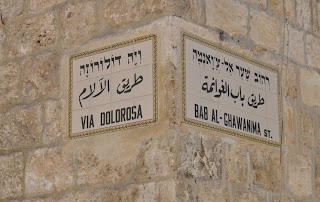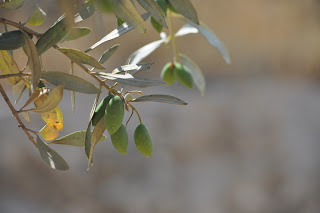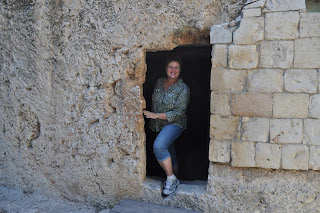On the last day of the tour, we visited sites associated
with the passion and resurrection. You should remember that I am a lay
person, not a student of biblical archaeology, and I am relying on memory. So if
one of my accounts does not match some expert’s account, go with the expert.
Here’s a view of the Old Jerusalem from Mount of Olives.
We’re facing west and are a little farther south than Jesus would have been
when He halted His triumphal entry procession to weep over the city. You can
see all the caskets that cover the hill. Many believe this will be prime real
estate when the Messiah comes (either the first or second time, depending on
your religious background) and they want to be near the epicenter of the
resurrection.
The stones on the caskets are a sign of respect. They last
longer than roses, and the breeze doesn’t blow them away.
We entered the Tombs of the Prophets, and you’re about to go
there with me.
Once your eyes have accustomed to the dark inside, you see
that you’re in a large room with side rooms. Dead people would be laid out on a
slab and left to rot. Meanwhile a stone would be rolled across the mouth of the
cave so that animals wouldn’t desecrate the body.
Later, when another person died, they would roll away the
stone and bring in the fresh corpse. If the former one was decomposed so that
only bones were left, they would gather the bones and put them in an ossuary (a
small bone box carved from stone) and slide them into one of the smaller
cubbies that surrounded the central room. It sounded like sometimes their bones
would just be gathered up and placed on the bones of the ancestors. This is
what was meant when they said, “And Abraham was gathered to his fathers.”
Back on the surface, there’s a beautiful church honoring
Mary Magdalene. Of course, hers would be the sparkliest.
Carl bypassed the traditional Gethsemane and took us to a
spot that would have been more like the natural landscape of the time. We spent
some moments in reflection there. Later, Ginger read that some scholars believe
this would have been a more likely spot for Christ’s final conference with His
Father than the traditional site which is too close to a main thoroughfare.
And yes, there were olives growing there. Gethsemane means “oil
press” so it was a place where these fruits would be put under tremendous
pressure to remove the oil that would light the lamps in the temple, feed the
populace, and manage more menial tasks.
Our guide in Nazareth explained that the olives were first
crushed with a large stone wheel.
Then they were pressed three times: first, for God; second,
for man; and third, for common use. He showed us the huge crushing weights that
were used to press the oil from the pulp. It seems like a fitting symbol for
the pressure that Christ endured in Gethsemane. (This press was in Nazareth, not here in Gethsemane, though in days of old one would have been here.)
Later that night, Jesus ended up at Caiaphas’ palace which
was probably this ruins. It was here that people believe Peter denied knowing
Jesus three times. And, of course a church rises over the spot.
The ruined palace is down the slope from the church, but
directly under it is the pit in which Jesus was held until He could be tried by
Pilate the next morning. This was prophesied in Psalm 88, “You have plunged me
into the bottom of the pit.”
Next stop was near the Antonia Fortress and, yes, another underground
holding place.
Carl shared passages related to Christ’s mistreatment by the
Roman soldiers which, as you will remember were actually local Samaritan hires
commissioned by the power of Rome.
It was from here that Christ began His long walk to the
place of crucifixion. In this underground chamber, almost in a forgotten corner
someone invested much artistic effort to construct a beautiful mosaic of the
Christ whose actual message also seems to occupy an almost forgotten corner. We
focus on and clash over the details of theologies that have arisen since His
walk here, but His main message of forgiveness and of the divine affinity for
all people is often barely given a corner. We may loudly claim it for
ourselves, but barely practice it towards those we dislike or distrust.
If He came to accomplish some cosmic requirement essential
for our salvation, hallelujah! We should be eternally grateful. But the surest
sign of our gratitude would be to live as He lived; seeing with hope the value
of our enemies.
Another remaining structure is this arch from which Pilate
declared, “Behold the man!” prior to Jesus’ death walk.
Today when you travel the Via Dolorosa you pass shop after
shop. They are not hawking religious relics but spices, clothing, food, etc.
Anybody for some fresh pita?
This is definitely a well-traveled lane for today’s masses.
I’m not sure what put the bright light around this woman’s eyes, but it’s a
striking photo, don’t you think?
A common T-shirt was the “Guns and Moses” one on display
here. If you order one, they will have you look at blanks, choose your size and
color, pick the art from a drawer of choices, and do the heat transfer there
before your eyes.
In time you wend your way to the traditional spot of the
crucifixion and true to form a huge stone shrine covers the spot. This woman is
placing her hand in the hole where they claim the cross was planted. Again the
spot is so marble-encrusted that it stretches the imagination to envision a
God-forsaken rocky knoll upon which countless crosses had been erected.
A little lower, but in the same shrine is the slab they
believe He was laid on when removed from the cross. Today the devout bring
their souvenirs and icons to lay on the stone. I assume this is to allow the
item to soak up some of the lingering holiness before packing them into
suitcases for the trip home. Again I wonder about the dividing line between
reverence and superstition.
Within the same shrine (did I mention it was very large?) is
this two-storey structure that was built over the spot where they claim Jesus
was buried. That is natural light seeming to draw things up from this
ceramic-oven-shaped shrine-within-a-shrine.
Yes, you can go in to see the spot and again touch where He
was laid, but you will be at the direction of a very business-like priest who
had mastered several words in English: “Come, come come. Go, go, go. Stop!”
Pilgrims get instructions from a variety of sources. This
sign seems reasonable, but I think the sign-maker’s attention drifted when
he/she matched the words to the photos.
There is some disagreement on exactly where Jesus was
crucified and buried. The Garden Tomb is a relatively recent discovery, and
there are some arguments for why it should be considered the real spot. The
arguments have not convinced Carl, but he took us there, because it presents a
better place for contemplation. The hill is less developed, though a bus lot
has been built which has obscured the lower half of the hill. An arrangement of
caves on the face of this cliff created the appearance of the face of a skull.
Hence, its discoverers felt this would have been called Golgotha, the Place of
the Skull.
Nearby is a family burial tomb thought to be Joseph’s. Some
stone work and an engraved Byzantine cross makes one wonder what else the
Church would have been commemorating as they were in possession of this land long
ago. Inside is a plaque which reads “He is not here for He is risen.” That is
our belief and our hope. Regardless of the controversies that raged around His
ministry, and the ones that still continue about His final hours and His
remains (or lack of them) we read a gospel that brims with hope in a life that
transcends this one; a vision that lifts us above the threats of our current
world and focuses us on the One who loves us and has set our worth above the
heavens. All of the hubbub, the argument, and the devotion that continue 2,000
years later are themselves an affirmation of the veracity of Jesus. What other
being has so dominated the philosophical, political, and archaeological
landscape?





























No comments:
Post a Comment